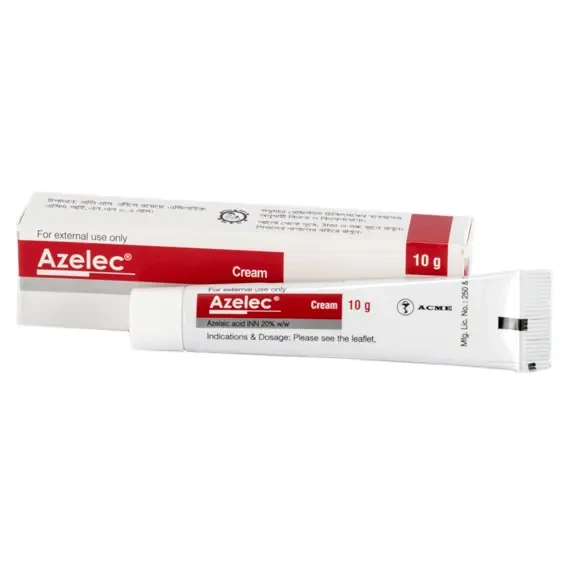Azelec Uses, Dosage, Side Effects and more
Azelaic acid is a naturally-occurring aliphatic dicarboxylic acid that inhibits the growth of Propionibacterium acnes and reduces keratinisation, thus restricts the development of comedones.
Azelaic acid is a saturated dicarboxylic acid found naturally in wheat, rye, and barley. It is a natural substance that is produced by Malassezia furfur (also known as Pityrosporum ovale), a yeast that lives on normal skin. It is effective against a number of skin conditions, such as mild to moderate acne, when applied topically in a cream formulation of 20%. It works in part by stopping the growth of skin bacteria that cause acne, and by keeping skin pores clear. Azelaic acid's antimicrobial action may be attributable to inhibition of microbial cellular protein synthesis.

| Attribute | Details |
|---|---|
| Trade Name | Azelec |
| Generic | Azelaic Acid |
| Azelaic Acid Other Names | 1,7-dicarboxyheptane, 1,9-nonanedioic acid, Acide azélaïque, Ácido azelaico, Acidum acelaicum, Acidum azelaicum, Anchoic acid, Azelaic acid, Azelainsäure, Lepargylic acid, n-nonanedioic acid, Nonandisäure, Nonanedioic acid |
| Weight | 20% |
| Type | Cream |
| Formula | C9H16O4 |
| Weight | Average: 188.2209 Monoisotopic: 188.104859 |
| Groups | Approved |
| Therapeutic Class | Acne treatment preparations |
| Manufacturer | Acme Laboratories Limited |
| Available Country | Bangladesh |
| Last Updated: | January 7, 2025 at 1:49 am |
Uses
Azelaic acid is used for acne vulgaris, rosacea.
Azelec is also used to associated treatment for these conditions: Acne Vulgaris, Inflammatory lesions caused by rosacea, Susceptible Bacterial Infections, Nutritional supplementation
How Azelec works
The exact mechanism of action of azelaic acid is not known. It is thought that azelaic acid manifests its antibacterial effects by inhibiting the synthesis of cellular protein in anaerobic and aerobic bacteria, especially Staphylococcus epidermidis and Propionibacterium acnes. In aerobic bacteria, azelaic acid reversibly inhibits several oxidoreductive enzymes including tyrosinase, mitochondrial enzymes of the respiratory chain, thioredoxin reductase, 5-alpha-reductase, and DNA polymerases. In anaerobic bacteria, azelaic acid impedes glycolysis. Along with these actions, azelaic acid also improves acne vulgaris by normalizing the keratin process and decreasing microcomedo formation. Azelaic acid may be effective against both inflamed and noninflamed lesions. Specifically, azelaic acid reduces the thickness of the stratum corneum, shrinks keratohyalin granules by reducing the amount and distribution of filaggrin (a component of keratohyalin) in epidermal layers, and lowers the number of keratohyalin granules.
Dosage
Acne vulgaris:
- Adult: As 20% cream or 15% gel: Apply thinly into the affected areas bid (morning and evening) after cleansing. Improvement may be detectable w/n 4 wk. Duration of treatment: Up to 6 mth.
- Child: ≥12 yr Same as adult dose.
Rosacea:
- Adult: As 15% gel: Apply thinly into the affected areas bid (morning and evening). Improvement occurs in 4-8 wk.
- Child: ≥12 yr Same as adult dose.
How Long Does It Take to Work?
How Long Does It Take to Work? see here Azelec
Side Effects
Burning, erythema, stinging, pruritus, dryness and scaling, peeling, irritation, dermatitis, hypopigmentation, rash, and photosensitivity. Rarely, exacerbation of asthma.
Toxicity
Oral LD50 in rat: >5 g/kg
Precaution
Patient with sensitive skin. Not intended for application to broken, sunburnt or eczematous skin. Avoid use of occlusive dressing or wrappings. Pregnancy and lactation.
Interaction
Avoid spicy foods, alcoholic beverages and hot drinks that might provoke erythema, flushing and blushing during treatment of rosacea.
Food Interaction
- Avoid alcohol. Alcohol may cause flushing; therefore, it may worsen rosacea.
- Take with or without food. Food and drink, which have a high temperature or are spicy, may exacerbate flushing and rosacea, avoid if possible.
Elimination Route
Approximately 4% of the topically applied azelaic acid is systemically absorbed.
Half Life
The observed half-lives in healthy subjects are approximately 45 minutes after oral dosing and 12 hours after topical dosing, indicating percutaneous absorption rate-limited kinetics.
Elimination Route
Azelaic acid is mainly excreted unchanged in the urine, but undergoes some ß-oxidation to shorter chain dicarboxylic acids.
Pregnancy & Breastfeeding use
Pregnancy Category B. Either animal-reproduction studies have not demonstrated a fetal risk but there are no controlled studies in pregnant women or animal-reproduction studies have shown an adverse effect (other than a decrease in fertility) that was not confirmed in controlled studies in women in the 1st trimester (and there is no evidence of a risk in later trimesters).
Contraindication
azelaic acid cream is contraindicated in individuals who have shown hypersensitivity to any of its components.
Storage Condition
Store between 15-30° C.
Innovators Monograph
Azelec contains Azelaic Acid see full prescribing information from innovator Monograph, MSDS, FDA label



